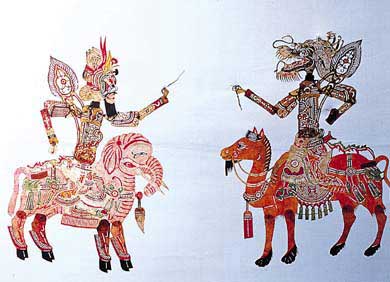作為上海世博會(huì)河北周的特色表演,唐山皮影戲在寶鋼大舞臺(tái)亮相。皮影雕花精致,小巧玲瓏,在工作人員嫻熟的“指揮”下,皮影活靈活現(xiàn)地展現(xiàn)在游客面前。那么,皮影戲在英文中該如何表達(dá)呢?那就是shadow play或者shadow puppetry。
It is an ancient form of storytelling and entertainment using opaque figures in front of an illuminated backdrop to create the illusion of moving images.
這是一種古老的表演藝術(shù),用不透光的剪影形象在一個(gè)照亮的背景布上形成投影,用來表演一個(gè)故事。
在臺(tái)灣,皮影戲由the Chaochow school of shadow puppet theatre(潮州皮影)發(fā)展而來,通常被稱為leather monkey shows(皮猴戲)。

Older puppeteers estimate that there were at least a hundred shadow puppet troupes in southern Taiwan in the closing years of the Qing. Traditionally, the eight to 12-inch puppet figures, and the stage scenery and props such as furniture, natural scenery, pagodas, halls, and plants are all cut from leather。
老一輩皮影藝人說,在清末,臺(tái)南至少有100家皮影劇團(tuán)。傳統(tǒng)臺(tái)灣皮影中8-12寸大小的人物剪影、舞臺(tái)道具包括家具、自然景觀、寶塔。殿堂和樹木花草等都是用皮革做成的。
在法國(guó),皮影戲雖然一開始也是從中國(guó)流傳過去,但是加入本地特色后,這種表演立刻變成了原汁原味的法國(guó)藝術(shù):
The show began to spread to Europe in the mid-18th century, when French missionaries in China took it back to France in 1767 and put on performances in Paris and Marseilles, causing quite a stir. In time, the Ombres chinoises (French for "Chinese Shadows") with local modification and embellishment, became the Ombres fran?aises and struck root in the country。
皮影戲是十八世紀(jì)中期傳到歐洲的,法國(guó)傳教士在1767年將皮影戲帶回法國(guó),在巴黎和馬賽舉辦表演,引起一陣轟動(dòng)。馬上,“中國(guó)影戲”被改造,加入了法國(guó)特色元素,成為“法國(guó)影戲”,并在法國(guó)長(zhǎng)期流傳下來。
在印度、印尼、馬來西亞、泰國(guó)、土耳其,都有shadow theatre的傳統(tǒng)。而德國(guó)動(dòng)畫界首創(chuàng)了剪紙動(dòng)畫,silhouette animation,是用和皮影戲一樣的木偶一格一格,frame-by-frame地拍攝出來的。
相關(guān)閱讀
世博“預(yù)約券” reservation ticket
世博會(huì)上的“協(xié)助犬”
世博概念股 Expo-related stocks
世博護(hù)照 Expo passport
(來源:滬江英語 編輯:Julie)